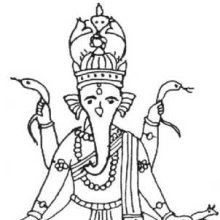Dharanendra, Dharaṇendra, Dharana-indra: 4 definitions
Introduction:
Dharanendra means something in Jainism, Prakrit, Hinduism, Sanskrit. If you want to know the exact meaning, history, etymology or English translation of this term then check out the descriptions on this page. Add your comment or reference to a book if you want to contribute to this summary article.
Images (photo gallery)
In Jainism
General definition (in Jainism)
Source: archive.org: The Jaina IconographyDharaṇendra (धरणेन्द्र) (or Pārśva, Vāmana) is the name of the Yakṣa accompanying Pārśvanātha: the twenty-third of twenty-four Tīrthaṃkaras or Jinas, commonly depicted in Jaina iconography.—Pārśvanātha is one of the greatest Tīrthaṃkaras or Prophets of Jainism. [...] From all sources, we gather his emblem or cognizance is a snake. In sculpture, snake seems to be everything with him. Not only do we find snake in the usual place of the symbol, we find, snakes canopy him with three or seven or eleven hoods. His Yakṣa is called Pārśva or Vāmana or Dharaṇendra and Yakṣiṇī is called Padmāvatī. The king, who stands by his side as a Chowri-bearer is known as Ajitarāja. The Devadāru (Deodar) or Dhātaki is his Kevala-tree.
The very name Dharaṇendra, or Dharaṇīdhara clearly signifies his identity with Śeṣanāga, the king of the serpents. In actual iconography, we find this Yakṣa has snake-symbols abundantly besides the snake-hoods. He holds also Vāsuki, the king of snakes (said to be ason of Kāśyapa). His vehicle of a tortoise might suggest his superiority over Kamaṭha (Kamaṭha=tortoise) , who had been his and his master’s enemy for ages.
Source: archive.org: Trisastisalakapurusacaritra1) Dharaṇendra (धरणेन्द्र) was friendly towards Pārśvanātha: the twenty-third of the twenty-four Tīrthaṅkaras praised in the first book (ādīśvara-caritra) [chapter 1] of Hemacandra’s 11th century Triṣaṣṭiśalākāpuruṣacaritra: an ancient Sanskrit epic poem narrating the history and legends of sixty-three illustrious persons in Jainism. Accordingly, “[...] may the Lord Pārśvanātha, whose attitude of mind was the same toward Kamaṭha and Dharaṇendra while each was performing actions characteristic of himself, be for your emancipation”.
Note: Kamaṭha was Pārśvanātha’s enemy and Dharaṇendra his friend, as the result of an incident in a former birth. See Bloomfield: Life and Stories of the Jaina Savior Pārśvanātha, pp. 9 ff.
2) Dharaṇendra (धरणेन्द्र) is the name of an ancient Ṛṣi, according to chapter 5.1 [śāntinātha-caritra].—Accordingly:—“Knowing that Aśanighoṣa was versed in vidyās, Arkakīrti’s son went with his son, Sahasraraśmi, not inferior in power, to Mt. Himavat to subdue for himself the vidyā named Mahājvālā, which destroys the vidyās of enemies. There he engaged in pratimā for seven days with a month’s fast at the very purifying feet of Ṛṣi Jayanta engaged in pratimā and also of Dharaṇendra and he began the work of subduing the vidyā. [...]”.
Source: The University of Sydney: A study of the Twelve ReflectionsDharaṇendra (धरणेन्द्र) refers to the “chief of the snakes”, according to the 11th century Jñānārṇava, a treatise on Jain Yoga in roughly 2200 Sanskrit verses composed by Śubhacandra.—Accordingly, “The doctrine is able to produce the happiness which is the best part of the city of the chief of the snakes [com.—Dharaṇendra]. The doctrine is the great joy conveyed to the world of mortals for those possessing a desire for that. The doctrine is the place of the arising of the taste for the constant happiness in the city of heaven. Does not the doctrine make a man fit for pleasure with a woman [in the form] of liberation?”,

Jainism is an Indian religion of Dharma whose doctrine revolves around harmlessness (ahimsa) towards every living being. The two major branches (Digambara and Svetambara) of Jainism stimulate self-control (or, shramana, ‘self-reliance’) and spiritual development through a path of peace for the soul to progess to the ultimate goal.
Languages of India and abroad
Sanskrit dictionary
Source: DDSA: Paia-sadda-mahannavo; a comprehensive Prakrit Hindi dictionary (S)Dharaṇendra (धरणेन्द्र) in the Sanskrit language is related to the Prakrit word: Dharaṇiṃda.
Sanskrit, also spelled संस्कृतम् (saṃskṛtam), is an ancient language of India commonly seen as the grandmother of the Indo-European language family (even English!). Closely allied with Prakrit and Pali, Sanskrit is more exhaustive in both grammar and terms and has the most extensive collection of literature in the world, greatly surpassing its sister-languages Greek and Latin.
See also (Relevant definitions)
Partial matches: Dharana, Indra, Tarana.
Starts with: Dharanendradrishtanta.
Full-text (+85): Dharanimda, Meghamalin, Kamatha, Katha, Vamana, Dharanidhara, Parshva, Pracetas, Parshvanatha, Devadaru, Dhataki, Mahajvala, Parshvayaksha, Muktahara, Kalikeya, Shvapaki, Kusumacula, Hamsagarbha, Lakshmiharmya, Sarvasiddhastuta.
Relevant text
Search found 5 books and stories containing Dharanendra, Dharaṇendra, Dharana-indra, Dharaṇa-indra; (plurals include: Dharanendras, Dharaṇendras, indras). You can also click to the full overview containing English textual excerpts. Below are direct links for the most relevant articles:
Jain Remains of Ancient Bengal (by Shubha Majumder)
Images of Tīrthaṅkara Pārśvanātha (Introduction) < [Chapter 6 - Iconographic Study of Jaina Sculptural Remains]
Tīrthaṅkara Pārśvanātha with Planetary deities and Dikpālas type < [Chapter 6 - Iconographic Study of Jaina Sculptural Remains]
The twenty-four Tīrthaṅkaras and their Yakṣas and Yakṣiṇīs < [Chapter 6 - Iconographic Study of Jaina Sculptural Remains]
Trishashti Shalaka Purusha Caritra (by Helen M. Johnson)
Part 8: Marriage with Vidyādharī Śyāmā < [Chapter II - Marriages of Vasudeva with maidens]
Part 5: Description of Vaitāḍhya < [Chapter III]
Part 1: Introduction < [Chapter I]
Bhagavati-sutra (Viyaha-pannatti) (by K. C. Lalwani)
Part 5 - Nāga-king Dharaṇendra < [Chapter 1]
Part 2 - Family of Valīndra < [Chapter 5]
Part 2 - Thirty-three Gods of Valīndra and Dharaṇendra < [Chapter 4]
Jainism in Odisha (Orissa) (by Ashis Ranjan Sahoo)
Iconography of Jain Gods and Goddess < [Chapter 6]
Narrative Panels in Odisha < [Chapter 5]
Sutrakritanga (English translation) (by Hermann Jacobi)
Lecture 6: Praise Of Mahavira < [Book 1]
